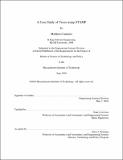| dc.contributor.advisor | Nancy Leveson. | en_US |
| dc.contributor.author | Couturier, Matthieu (Matthieu Jean) | en_US |
| dc.contributor.other | Massachusetts Institute of Technology. Technology and Policy Program. | en_US |
| dc.date.accessioned | 2010-10-29T13:50:21Z | |
| dc.date.available | 2010-10-29T13:50:21Z | |
| dc.date.copyright | 2010 | en_US |
| dc.date.issued | 2010 | en_US |
| dc.identifier.uri | http://hdl.handle.net/1721.1/59557 | |
| dc.description | Thesis (S.M. in Technology and Policy)--Massachusetts Institute of Technology, Engineering Systems Division, Technology and Policy Program, 2010. | en_US |
| dc.description | This electronic version was submitted by the student author. The certified thesis is available in the Institute Archives and Special Collections. | en_US |
| dc.description | Cataloged from student submitted PDF version of thesis. | en_US |
| dc.description | Includes bibliographical references (p. 152-157). | en_US |
| dc.description.abstract | The goal of this thesis is to investigate and demonstrate the application of a systems approach to drug safety. The recall of the prescription drug Vioxx (Rofecoxib) was used as a test case to study whether STAMP (Systems Theoretic Accident Model and Processes) could be used to outline the interactions between the different pharmaceutical system components, identify the safety control structure in place and understand how this control structure failed to prevent the marketing of an unsafe drug which killed an estimated 27,000 people in the United States. To supplement this static analysis, System Dynamics models were used to analyze the social and organizational dynamics that underline the US healthcare system and to understand how the system moved from a safe to an unsafe state which allowed a dangerous drug to be left on the market for over five years. The recall of Vioxx was followed by a number of legislative changes, in particular the Food and Drug Administration Amendment Act of 2007. Those changes were mapped on the safety control structure and again System Dynamics models were used to understand the systemic implications of the policy changes. The models suggested that further changes might be necessary to protect the American public and so, based on the results of the STAMP analysis, a new set of systemic recommendations was proposed. | en_US |
| dc.description.statementofresponsibility | by Matthieu Couturier. | en_US |
| dc.format.extent | 157 p. | en_US |
| dc.language.iso | eng | en_US |
| dc.publisher | Massachusetts Institute of Technology | en_US |
| dc.rights | M.I.T. theses are protected by
copyright. They may be viewed from this source for any purpose, but
reproduction or distribution in any format is prohibited without written
permission. See provided URL for inquiries about permission. | en_US |
| dc.rights.uri | http://dspace.mit.edu/handle/1721.1/7582 | en_US |
| dc.subject | Engineering Systems Division. | en_US |
| dc.subject | Technology and Policy Program. | en_US |
| dc.title | A case study of Vioxx using STAMP | en_US |
| dc.title.alternative | Case study of Rofecoxib using STAMP | en_US |
| dc.title.alternative | Case study of Vioxx using Systems Theoretic Accident Model and Processes | en_US |
| dc.type | Thesis | en_US |
| dc.description.degree | S.M.in Technology and Policy | en_US |
| dc.contributor.department | Massachusetts Institute of Technology. Engineering Systems Division | |
| dc.identifier.oclc | 668214373 | en_US |
